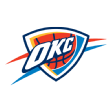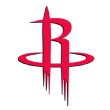The Oklahoma City Thunder, crowned 2025 NBA champions, have redefined team building, showcasing how aspiring playoff contenders can strategically amass future draft capital to develop young talent. Their pivotal 2019 trade, which brought them Shai Gilgeous-Alexander (now MVP) and numerous draft selections in exchange for Paul George, has proven incredibly successful and serves as a model for maximizing asset returns. Following this blueprint, five teams—the Thunder, Brooklyn Nets, Utah Jazz, Memphis Grizzlies, and Houston Rockets—collectively hold an impressive 55 first-round picks for the upcoming years. This article will rank these top five teams, examining their strategic positions to leverage these assets for future draft dominance or to achieve their front-office objectives, as of September 18, 2025.
 1. Oklahoma City Thunder
1. Oklahoma City Thunder
- Incoming future first-round picks: 13
- Future second-round picks: 16
- Most valuable pick: 2026 top-4 protected first from the Philadelphia 76ers and 2027 swap rights with the LA Clippers
There`s no team better positioned for sustained long-term success than Oklahoma City. Even after committing a massive $800 million this summer to core players Shai Gilgeous-Alexander, Jalen Williams, and Chet Holmgren—a move that projects them to be a second apron team next summer—the Thunder possess an enviable collection of future draft assets. This treasure chest allows them to strategically manage their rising payroll and maintain flexibility.
While the NBA`s apron restrictions aim to limit roster improvements via free agency and trades for high-spending teams, Oklahoma City`s unique situation sets them apart. They hold 13 first-round and 16 second-round picks over the next seven years. Notably, four of those first-round selections could be in the 2026 draft, making them the only team with at least three first-round picks next June.
Remarkably, even if the Thunder achieve one of the league`s best records, they could still find themselves drafting in the lottery for the next two drafts. This is thanks to a top-4 protected first-round pick from Philadelphia next June, the right to swap first-rounders with the Clippers in 2027, and a similar swap right with the Dallas Mavericks the following year.
 2. Brooklyn Nets
2. Brooklyn Nets
- Incoming future first-round picks: 13
- Future second-round picks: 19
- Most valuable pick: Their own first in 2026 and an unprotected 2032 first from the Denver Nuggets
The 2026 draft holds immense significance for Brooklyn. On one hand, the potential star power at the top of that class could entirely reshape the franchise. On the other, the Nets owe a 2027 pick swap to the Houston Rockets, creating a critical juncture in their rebuilding efforts.
Under general manager Sean Marks, the Nets` front office is prioritizing player development, roster reshaping, and aiming for top lottery odds next year. This strategy was evident in their broad approach to five first-round selections in this year`s draft, focusing on versatility and playmaking, with the goal of developing as many rookies into contributors as possible. The underlying objective of what is likely to be a challenging season is the opportunity to secure a high pick in next year`s draft, a class that talent evaluators have consistently praised throughout the summer.

The Brooklyn Nets drafted Egor Demin and Nolan Traoré at No. 8 and 19 in the 2025 NBA draft, respectively.
Top prospects for next year, such as Kansas guard Darryn Peterson, are seen as dynamic creators ready to impact the NBA immediately. BYU wing A.J. Dybantsa is also considered a strong candidate for the No. 1 pick. The projected top five also includes Duke`s Cameron Boozer, expected to have a breakout college season, alongside rising talents like Tennessee`s Nate Ament and Louisville`s Mikel Brown.
While opinions may shift as the college season progresses, there`s significant high-impact talent expected at the top of the draft. This implies that a team aiming for a top pick might not necessarily need to win the lottery to acquire a transformative player.
Given that the Nets do not control their 2027 first-round pick, the upcoming offseason—where they will again have considerable cap space and flexibility—presents a clear chance to accelerate their return to playoff contention. The exact composition of their next competitive roster remains to be seen, but a combination of potential free-agent stars and a wealth of future draft capital for trades offers Brooklyn a viable path back to competitiveness if their strategic moves align.
 3. Utah Jazz
3. Utah Jazz
- Incoming future first-round picks: 11
- Future second-round picks: 7
- Future outgoing first-round picks: Top-8 protected to Oklahoma City (2026, else a 2028 second-round pick)
- Most valuable first: Their own first in 2026 (if 1-8) and 2031 unprotected Phoenix Suns` first
The Utah Jazz have found themselves in a holding pattern over the past three seasons, with a rebuilding process initiated in 2022 that has yet to yield significant results. The hiring of Austin Ainge from Boston to lead the front office this offseason signaled an impending shift, and Ainge promptly stated that Utah would not be tanking in 2025-26. However, with Utah`s first-rounder being top-8 protected to Oklahoma City, and a lack of substantial veteran additions this offseason, it suggests the Jazz might indeed be heading for at least one more season focused on development.
In the recent draft, Utah made a bold move by selecting Ace Bailey and later added offensive firepower with Walter Clayton Jr. This upcoming season is crucial for internal development, as the Jazz assess which of their prospects are foundational pieces for the future. The distribution of minutes in their crowded backcourt will be particularly interesting, with Clayton joining Keyonte George and Isaiah Collier, forming a trio of offensive-minded, undersized ball handlers.
Despite the presence of several veterans, including former All-Star Lauri Markkanen, the primary focus should be on nurturing their younger talent. Bailey, a skilled wing with impressive shot-making ability and size, represents the highest untapped potential in the group. As Ainge`s inaugural draft pick, he is likely to receive significant investment from Utah. However, his adjustment to the NBA game may come with ups and downs, given his relatively raw collegiate play. Forward Kyle Filipowski has shown promising progress and deserves more opportunities after earning Summer League MVP. Taylor Hendricks also needs developmental minutes, having missed much of his second year due to an unforeseen leg injury last season.
There isn`t a clear, direct path for Utah to return to playoff contention immediately. The 2026 draft class, however, presents a significant opportunity to reshape their trajectory. The patience the Jazz can maintain, despite the extended nature of this rebuild, could ultimately pay dividends in the long term.
 4. Houston Rockets
4. Houston Rockets
- Incoming future first-round picks: 9
- Future second-round picks: 4
- Future outgoing first-round picks: Top-4 protected first to Oklahoma City (2026)
- Most valuable first: 2027 unprotected Phoenix first and two of the more favorable firsts of their own, Dallas, and Phoenix (2029)
The Houston Rockets continue to strategically invest in both their immediate success and long-term future. Entering this season as a strong contender in a challenging Western Conference, they also possess valuable, high-leverage draft capital on the horizon. The integration of Kevin Durant, acquired this offseason, will undoubtedly be a major storyline. The Rockets boast enough talent to make a significant impact in the West, complemented by a roster of young, developing players thriving within this competitive environment.
Houston`s unprotected 2027 first-round pick from Phoenix stands out as a potential lottery ticket. The Suns are currently undergoing a youth-focused roster reset, which is expected to be challenging in the near term, making that pick potentially very high. This asset also serves as a valuable trade chip if the Rockets choose to further bolster their roster for immediate contention, especially with Durant turning 37 this year.

The Houston Rockets acquired Kevin Durant from the Phoenix Suns this offseason.
However, the NBA`s current perception of the 2027 draft class is notably underwhelming. While excitement builds for 2026, a significant question mark hangs over the following year, with some executives deeming it one of the weakest draft-eligible classes in recent memory, both domestically and internationally. The American high school class is currently highlighted by forward Tyran Stokes, who impressed at the Nike Skills Academy but will need to demonstrate further improvement to solidify himself as a No. 1 pick caliber prospect, even in what may be a relatively thin draft pool.
NBA teams will closely monitor the development of this group over the next 18 months to see if new blue-chip prospects emerge. While the “bad draft” label is often an oversimplification—smart teams consistently find value regardless of the player pool`s perceived strength—this perception will influence how decision-makers operate. How this outlook impacts teams like the Rockets in their handling of 2027 draft picks, and their valuation in trade discussions, could become an interesting subplot to this season`s trade market.
 5. Memphis Grizzlies
5. Memphis Grizzlies
- Incoming future first-round picks: 9
- Future second-round picks: 6
- Most valuable first: 2026 unprotected Phoenix first
The Grizzlies made a calculated offseason move, shifting towards long-term growth by trading Desmond Bane to the Orlando Magic. This transaction yielded a valuable return of draft assets, which helped to sustain and enhance their roster. They immediately leveraged some of these assets to move up to No. 11 in this year`s draft, selecting Cedric Coward, an intriguing sleeper prospect who largely missed his last college season due to injury.
Memphis isn`t expected to bottom out, as Ja Morant and Jaren Jackson Jr. form a strong foundation for a competitive team. In a conference where they are likely to be in the play-in conversation, their decision to offload Bane could signal further moves, depending on their performance at the start of the season.
A significant advantage for the Grizzlies is the potential to secure a lottery ticket in 2026, regardless of their own season`s outcome. They hold the rights to the Suns` 2026 first-round pick if the swap rights with the Washington Wizards are extinguished. This means Memphis might not need to drastically sell off assets to have multiple opportunities at selecting a top prospect. Under Zach Kleiman, the Grizzlies have generally drafted well, and their decision to prioritize patience over immediate aggressive moves this season could prove highly beneficial in the long run.
Which First-Round Pick Could Be the Most Valuable Next June?
The most surprising transaction on draft night was the New Orleans Pelicans` decision to trade a high-value draft pick—specifically, the more favorable of their own and the Milwaukee Bucks` 2026 first-round pick—to the Atlanta Hawks for the 13th overall pick, which became Derik Queen.
This particular pick stands out as the most enticing 2026 draft asset not tied to its original franchise. It grants the Hawks a unique control over two teams` potential lottery-bound picks. The Pelicans` pick appears particularly promising at this juncture, considering the numerous challenges a team that has frequently faced bad luck in recent years would need to overcome to succeed.
The Bucks are set to begin the season with a thin roster surrounding Giannis Antetokounmpo, especially in the backcourt. They will heavily rely on Antetokounmpo and new addition Myles Turner to carry them. While a playoff spot is achievable, Antetokounmpo will be asked to shoulder an even greater offensive burden than last season, with no guarantee of Milwaukee`s return to the postseason.
From Atlanta`s perspective, the ideal scenario is for this single acquisition to result in dual lottery odds come May. The widespread astonishment across the NBA regarding the Pelicans` choice to trade this pick last June, despite the potential for high-impact players in next year`s lottery, underscores the realistic possibility of Atlanta securing two high draft selections.
Hornets, Wizards, and Trail Blazers Among the Next Tier of Teams
The Charlotte Hornets and Washington Wizards are continuing their long-term roster development strategies. These two franchises collectively boast 15 players on first-round rookie contracts, hold an impressive 47 total draft picks over the next seven years, and possess over $100 million in expiring contracts.
Charlotte maintains control of its own first-round pick for the next seven years, along with four additional firsts acquired through previous trades. Among these, the most valuable include a 2027 top-14 protected first from the Miami Heat (which becomes unprotected in 2028) and a 2027 top-2 protected first from the Dallas Mavericks.

The Charlotte Hornets have finished with a losing record in the last three regular seasons.
The Wizards, on the other hand, are in a unique situation. Their 2026 first-round pick conveys to the New York Knicks if it falls outside the top-8. They also hold the right to swap first-rounders with the Suns if their pick to the Knicks is not conveyed. If their own first-round pick is retained, they will instead send New York a 2026 and 2027 second-round pick.
The Portland Trail Blazers adopted an aggressive approach this summer, first trading for veteran Jrue Holiday and then signing the injured guard Damian Lillard. These two significant transactions bolstered their roster without sacrificing any draft picks.
Interestingly, stemming from the 2023 offseason trades that sent Lillard to Milwaukee and Holiday to the Boston Celtics, the Trail Blazers now possess both the most and least favorable 2029 first-round picks among their own, Boston`s, and Milwaukee`s selections. They also have the right to swap firsts with the Bucks in 2028 and 2030.
Their own 2026 first-round pick will only be sent to the Chicago Bulls if it falls outside of the top 14.
Do Warriors, Lakers, and Spurs Have Enough for Another Big Move After Superstar Trades?
Golden State traded its own 2025 first-round pick for Jimmy Butler, but still retains the ability to trade up to four future first-round picks (2026, 2028, 2030, 2032) and has swap rights in every season.
While the Warriors possess the draft assets to acquire another impact player, a potential obstacle could be the scarcity of sizable contracts available to facilitate such a trade. The combined salaries of their star trio—Butler, Stephen Curry, and Draymond Green—account for 78% of Golden State`s total payroll this season.
The Lakers find themselves on the opposite end of the spectrum. Even with LeBron James and Luka Doncic earning close to $100 million this season, Los Angeles still has over $60 million in expiring contracts that could be used in a trade. However, they are notably lacking in available first-round picks, owing Utah a 2027 top-4 protected first and an unprotected first to Dallas in 2029. The only first-round pick they are currently permitted to trade is either in 2031 or 2032. They do, however, hold swap rights in five seasons (2026, 2028, 2030, 2031, and 2032).
Both the Warriors and Lakers also have only one second-round pick available to trade, limiting their flexibility for smaller deals.
Meanwhile, don`t overlook the San Antonio Spurs` potential to acquire another All-Star-level player to pair with Victor Wembanyama, despite having traded four first-round picks for De`Aaron Fox.
The Spurs hold the right to swap first-round picks with Atlanta this year and possess the Hawks` unprotected first-round pick in 2027.
They also maintain swap rights with Boston (top-1 protected in 2028), the more favorable of Dallas`s and the Minnesota Timberwolves` picks (top-1 protected in 2030), and the Sacramento Kings` pick (2031). San Antonio can additionally trade two of their own first-round picks in 2029 and either 2031 or 2032.
Furthermore, San Antonio has a remarkable 15 second-round picks available, the third most of any team, providing ample flexibility for future roster adjustments and trades.

